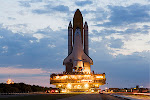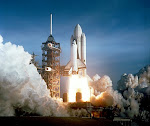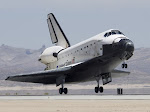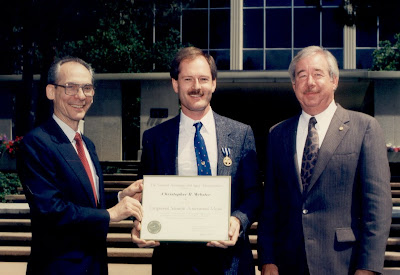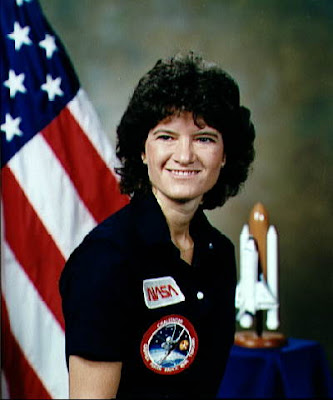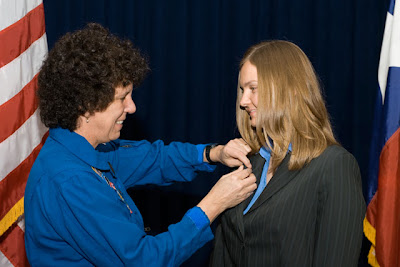
The final countdown has begun to the end of manned space flights by NASA, leaving some to fret that the nation's dreams of reaching for the stars may be in jeopardy under President Obama's plan to commercialize spaceflight.
Obama on April 15 will make the case for the most radical change of direction in NASA's history, wading into a debate laden with emotion, big bucks and ambitions that united a nation in a race to the moon a half-century ago.
After the space shuttle's aging orbiters are retired over the next year, NASA would exit the business of blasting astronauts into orbit under Obama's fiscal 2011 budget request.
NASA already had planned to book seats on Russia's rockets until the next U.S. space vehicle is ready to launch later this decade. Obama is gambling that Boeing or other nascent aerospace firms will develop the shuttle's replacement quicker and more cheaply than NASA.
If he's right, the president would provide a huge boost to space entrepreneurs, potentially unleashing the greatest new engine for innovation since the Internet, said aerospace analyst Marco Caceres with the Teal Group.
If he's wrong, the U.S. could be left dependent on Russia and China, its Cold War rivals, for spaceflight for much of the decade, critics warn.
That prospect is profoundly disturbing to such Apollo veterans as Gene Cernan, who was the last man to walk on the moon (in 1972).
"If we allow his budget to become the rule of the land, we in this country no longer have a manned space program," Cernan said. "In terms of going on to the moon or Mars, that's a generation away unless there are cooler heads in Congress."
The debate swirling around NASA is about how to get the biggest bang out of the space agency's research at a time of soaring budget deficits. Should NASA pick a target that will galvanize the nation, like landing a man on Mars and its moons, then develop the technology to reach Earth's neighbor through a series of ambitious and costly missions?
Or should the U.S. break with a half-century of tradition, as Obama wants? While China and India pour billions into duplicating America's lunar glories of the 1960s, NASA would dream up new ways to propel humans deep into space, while stepping up research on the international space station to help astronauts survive lengthy journeys to Mars or asteroids.
Quick trips to Mars
"Imagine the trips to Mars that take weeks instead of nearly a year; people fanning out across the inner solar system, exploring the moon, asteroids and Mars nearly simultaneously in a steady stream of 'firsts'; and imagine all of this being done collaboratively with nations around the world," said NASA Administrator Charles Bolden Jr. as he unveiled the strategic shift Feb. 1.
advertising
Using rockets to blast humans into low-Earth orbit is 50-year-old technology, the administration contends. Rather than tying up NASA resources, such flights should be outsourced to major NASA partners such as Boeing and Lockheed Martin and such upstarts as SpaceX, the rocket company founded by Internet magnate Elon Musk.
"What Obama wants to do is radical," said Caceres. "These companies will serve as the pioneers of many, many industries that we have not fathomed yet."
NASA a "science fair"
Obama would fund private contractors by scrapping NASA's current space- exploration program, Constellation, writing off the $9 billion already spent to return to the moon and eventually land humans on Mars. The president proposed to boost NASA's $19 billion budget by $6 billion over the next five years, with most of the increase used to seed commercial development.
However, critics claim that without an exploration program to keep NASA's goals in focus, the agency's research will devolve into a "science fair" whose funding eventually will be gutted by Congress without fear of political repercussions.
"Everybody who cares about the space program is skeptical about the president's space agenda," said Loren Thompson, a defense and aerospace analyst with the Lexington Institute. "It's not that the agenda is pointless, but it sounds like a pretext for abandoning goals."
Boeing is caught in the middle of the debate, because it is a major contractor for the Constellation program, space station and shuttle, and is angling to develop the orbiter's commercial replacement.
If Constellation is canceled and the shuttle retired, Boeing will lose billions of dollars in revenue and could lay off as many as 1,450 people. It's unclear whether the aerospace manufacturer will be able to offset those losses, Boeing officials said.
Boeing last month landed an $18 million contract from NASA to refine its concept for a commercial crew capsule, although NASA can't guarantee those designs will ultimately be used.
Boeing also plans to compete for the $5.8 billion that NASA intends to award to develop a commercial crew vehicle, although contest details remain sketchy.
"It's unclear what the future direction of NASA will be," said Keith Reiley, Boeing's commercial-crew development-program manager.
NASA had planned to depend on Russia's Soyuz rockets to reach the international space station after President George W. Bush set a 2010 deadline for ending the shuttle program. By mid-decade, Orion, an Apollo-like capsule that would ride atop a new family of rockets known as Ares, would be ready for launch. Later iterations would ferry U.S. astronauts to the moon and onward to deep space.
But Constellation has been badly underfunded, putting it years behind the former president's goal of reaching the moon by 2020, NASA's Bolden told Congress last month.
NASA estimated it would cost an extra $45 billion to $60 billion this decade to land astronauts on the moon five years later than Bush's deadline.
Glenn troubled
No one knows what private-sector vehicle will replace Orion if Constellation is canceled, however, or whether there will be sufficient demand to make space travel profitable. That troubles former U.S. Sen. John Glenn, the first American to orbit Earth, who thinks NASA should take a gradual path to privatization.
"I'm not certain that we're far enough along yet that the private sector can take up the slack in the whole program. That remains to be seen," Glenn said.
NASA officials are confident of their plan. The first commercial cargo flight to the space station is scheduled for 2011, and NASA thinks contractors could quickly develop simplified "space taxis" to ferry crew members to low-Earth orbit.
It's not clear where Orion fits into NASA's plans, since its vehicle was loaded with extra safety systems and equipment to take humans to the moon, at NASA's request, said John Karas, vice president and general manager of Human Space Flight for Lockheed Martin Space Systems. Orion is on schedule to fly in 2014.
"If the new administration wants to fly sooner and cheaper, there are ways to do it in our vehicle," Karas said.
But for now, Orion is funded only through the end of the fiscal year, and Karas worries its engineers will start to seek jobs elsewhere.
"Heaven help us if this fails. You'll never get people back," he said.

 Online banners and on-site activities are meant to gather more public support for their initiative. Thus far, Space reports, the campaigners have gathered more than 25,000 signatures for this. “Locating a shuttle at the Intrepid has been called a 'no-brainer' – and we couldn't agree more. With millions of American and foreign tourists visiting New York City every year, putting a shuttle at the Intrepid would create an ideal platform to share our national pride in our space program with the entire world, pay tribute to the men and women who have played a role in our greatest technological achievement, and provide an opportunity to educate future generations on the exploration of space,” said in a statement Bill White, who is the president of the Intrepid museum.
Online banners and on-site activities are meant to gather more public support for their initiative. Thus far, Space reports, the campaigners have gathered more than 25,000 signatures for this. “Locating a shuttle at the Intrepid has been called a 'no-brainer' – and we couldn't agree more. With millions of American and foreign tourists visiting New York City every year, putting a shuttle at the Intrepid would create an ideal platform to share our national pride in our space program with the entire world, pay tribute to the men and women who have played a role in our greatest technological achievement, and provide an opportunity to educate future generations on the exploration of space,” said in a statement Bill White, who is the president of the Intrepid museum.





